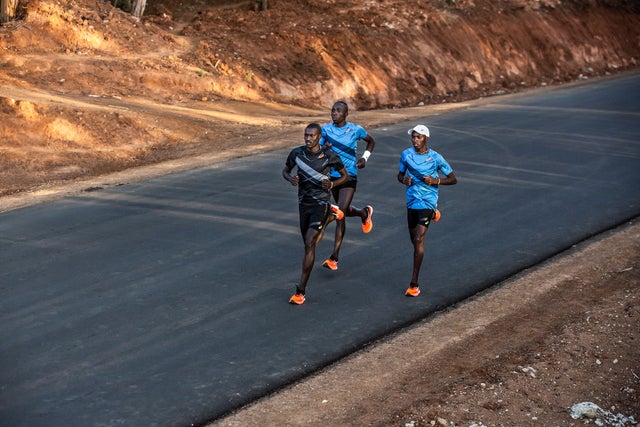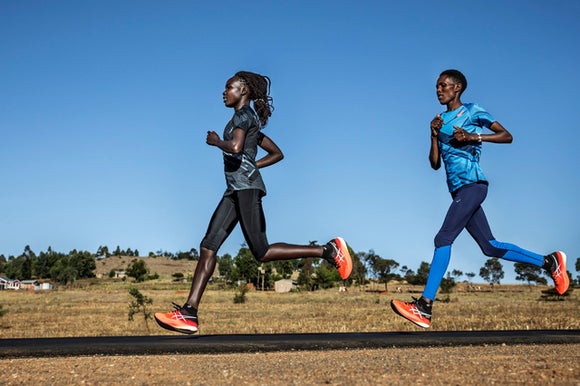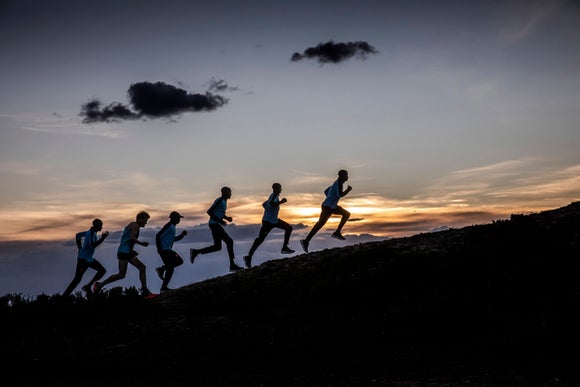How to Train Like a Kenyan
Running author, Scott Douglas, goes through some simple strategies to train like the world's best runners.
Updated: November 30, 2021

Wouldn't it be great to run like a Kenyan?
You're probably not going to move to Kenya to devote your entire life to running, and one hundred twenty miles might not be on next week's training schedule, but that doesn't mean you can't train like a Kenyan. I spent December 2004 in Iten, Kenya, the country's unofficial running capital, where Olympic medalists, world champions, and international marathon winners have been going to training for years. For a month, I ran with and talked to all types of runners, including road racers, track specialists, and cross country superstars, to see what common elements appeared throughout all of their training programs. Below is a collection of techniques that all runners, regardless of their specific race distance, experience, and talent level can easily add to their training regimens to train more like a Kenyan runner.
Start Slow, Finish Fast
Every run I did with Kenyan athletes started at a stumble and finished substantially faster. This is very different from how most recreational runners typically begin their runs, as they start out the door at the pace they think they should be running that day, and maintain roughly the same pace throughout the entirety of their run. For example, take a pot of water that is coming to a boil. There's no one instance where you can pinpoint when the water started to get hot, but the result is undeniable. The same thing happens when you allow your muscles and cardiovascular system to ease into your run, and as your body gradually warms up, your pace will quicken without really noticing it. Toward the end of your run, you'll be moving quickly and comfortably, and ultimately, you will be teaching yourself how to run fast but relaxed. Finishing faster than you start is also good practice for running negative splits in races.

Vary Very Much
One day, I was invited to join 12:52 5K runner, Isaac Songok, and world junior cross country champion, Augustine Choge, for their morning run. We completed roughly a 10K loop in about 49 minutes. For their next run, Songok and Choge covered the same loop in just under 31 minutes, which is about three minutes per mile faster! This disparity in intensity level from run to run is common among Kenyan training programs. To Kenyans, every run has a specific purpose, usually expressed in terms of "easy," "average," or "high speed". When it's time to go easy, Kenyans have no qualms running at the pace of a glorified trot. This low-intensity, active recovery allows the athletes to still get in volume while leaving them ready to nail the next hard workout. In contrast, most recreational runners run too hard on their easy training days and become too fatigued to be able to hit the times they're capable of during their hard training days. To reach your racing potential, follow the model set by the Kenyans: run easy runs easier, and run harder runs faster.
Everyone Needs a Buddy
One of the rarest sights in Kenya is seeing a runner training alone. Nearly every Kenyan runs with at least one, but more commonly, several other runners. Those who I asked about the subject simply stated that they wouldn't be able to train as hard if forced to run alone. Regularly running with others of similar ability has several benefits. For starters, you're much more likely to stick with your plans if others are present and counting on you. Also, on days when you're not feeling great, you'll get pulled along to better performances than you likely could have achieved on your own. Mentally, consistent training is less of a burden when you're with others instead of always having to will yourself out the door and down the road.

Tread Softly
After more than 25 years of running, my body has had its fair share of aches and pains. While I was in Kenya, despite the high altitude, constant hills, speedy company, and increasing my mileage by more than a third, those aches and pains weren't present. Sadly, three days after getting home, my usual problems were back once again.
This is mainly because, at home, I'm forced to do most of my running on asphalt, but in contrast, while in Kenya, every run was on dirt. If you don't believe that regularly running on soft surfaces is a lot better for your body, try this simple experiment:
- Take a golf ball on and bounce it off of asphalt or concrete, and observe how high the ball rebounds into the air. Now, try to bounce it on dirt, once again observing the height. Which golf ball rose higher?
The golf ball undoubtedly rebounded higher off the asphalt, and so, without diving into the physics of it all, this little test demonstrated the difference in the absorptive properties between pavement and dirt. In other words, the same forces which caused the golf ball to shoot into the air off of the asphalt, but to barely jump from the dirt, are the same forces that will affect the body while running. With every stride, your body is tasked with absorbing three to four times your body weight, so running on dirt, or a different type of soft surface as much as possible will keep runners feeling fresh longer, less susceptible to injury, and more likely to reach your running potential.
Hit the Hills
The town of Iten is located in the highlands of the Great Rift Valley, so running up and down hills is unavoidable. It's rare to go for more than a half-mile without being faced with a hill of at least some significance, and doing this day in and day out has obvious cardiovascular and muscular benefits. Most runners, however, don't live amid such perfect training terrain, but there's still a lot to learn from the Kenyan runners on this matter.
In addition to regularly running over hilly courses, Kenyans place great emphasis on targeted hill workouts, which are usually completed once a week, regardless of whether the runner is a marathoner, a miler, or competes at any distance in between. Most hill training days concentrate on several repeats, roughly 15 or more repetitions, on short hills that take 30 to 60 seconds to climb, and finish with a rest jog down the hill. These workouts can greatly improve your aerobic capacity, leg strength, explosive power, and range of motion, among other benefits, even if you never race on a hilly course.
Don't worry if your geographic location does not have Iten-like hills. The Kenyan, Henry Rono, who in 1978 set four world records in less than three months, was once asked about what type of hills he preferred for running repeats. The inquirer specifically wanted to know how steep, how long, and how constant a grade the hills Rono was running on, and he answered, "The hill? Any hill."

Run Diagonally
Another year-round staple in a Kenyan runner's training plan, regardless of the athlete's race discipline, is what is known as diagonals. This drill consists of running quickly from one corner of a playing field to another, jogging along the goal line to the opposite corner, striding from corner to corner, jogging the straight, and repeating. On the fast sections, the emphasis is on quick, graceful turnover and running relaxed while near top speed. These workouts improve your running form at all speeds and greatly enhancing your ability to kick at the end of races. Most Kenyans do at least 30 minutes of diagonals, and some do as much as an hour. If that seems too much for you at first, shoot for at least 15 minutes, preceded by 10-15 minutes of jogging. Never strain while doing diagonals, instead, try to run as fast as possible while staying under control and with good form.
Drill Your Skills
No one is born with perfect running form, and although they are incredible runners, Kenyans are not the exception. This is why Kenyans follow up every run with at least 10 more minutes of flexibility, range-of-motion, and form drills. Working daily on various aspects of the running motion helps Kenyans keep that long, flowing, seemingly effortless stride that every runner is trying to emulate. To incorporate this practice into your training routine, pick a handful of drills to do almost every day after your run. Key examples are high knees, quick feet, and various skip sequences. In just five minutes, you can do two sets of each over 30-50 meter distances, and over time, your running style will greatly improve. You might not be as fast as a Kenyan, but you can at least look like one.


